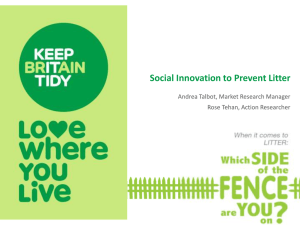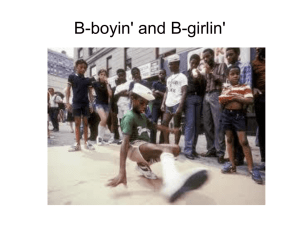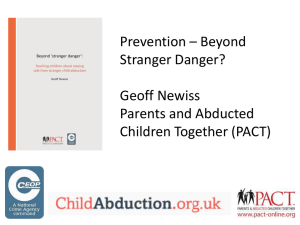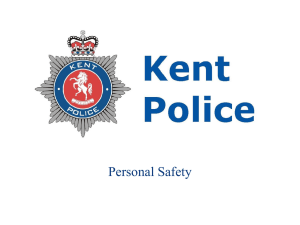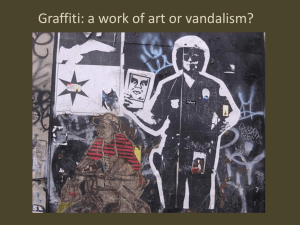Powerpoint - Schools` Safety Challenge
advertisement
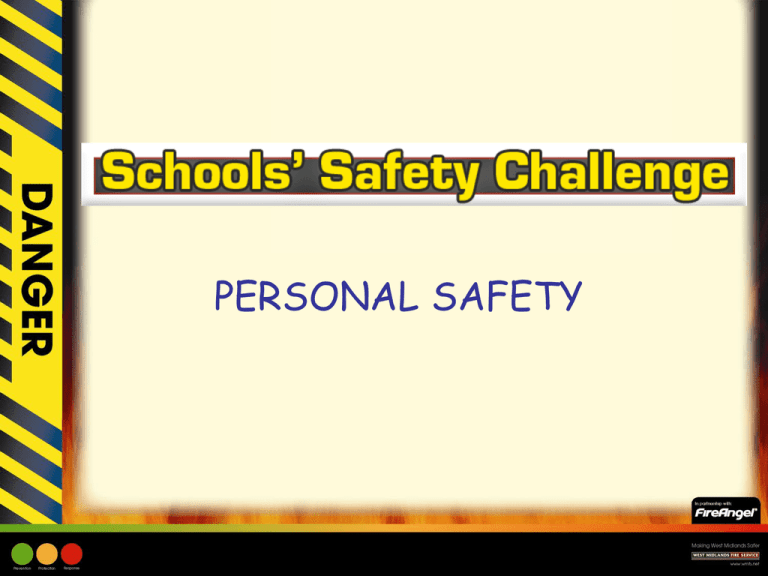
PERSONAL SAFETY PERSONAL SAFETY • Learning Objective: – Children to understand the importance of their own safety. – Children to learn how to keep safe and prevent accidents and injury. – Children to identify basic safety hazards and how to avoid them. PERSONAL SAFETY • Success Criteria: – Children will understand the importance of their own safety. – Children will learn how to keep safe and prevent accidents and injury. – Children can identify basic safety hazards and how to avoid them. PERSONAL SAFETY • Introduction: – In pairs you will be provided with a dictionary. – You are going to be given a word in which you need to find it’s definition. – We are going to share the information wit the rest of the class. – Could you provide examples real life examples for using these words? PERSONAL SAFETY • On your tables are various images. • Look at the images and discuss what could be the potential personal safety hazards and dangers? • We will then share your suggestions with whole class. • REMEMBER that it is very important to always be safe wherever we are and whatever we are doing! PERSONAL SAFETY • We are now going to look at various scenarios, and discuss the possible dangers; and what would be the most appropriate course of action to take. PERSONAL SAFETY Stranger Danger: – Commonly used to refer to the important topic of teaching children about the dangers you may face as you venture out into the world. Unfortunately the world is a scary place and there are people out there who prey on children. PERSONAL SAFETY Stranger Danger (Continued): – – – – Never accept gifts or sweets from a stranger. Never accept a lift in a car from a stranger. Never go anywhere with a stranger. Never go off on your own without telling a parent or trusted adult. – Never go up to a car to give directions - keep away so that no one can get hold of you and you can run away. – Always tell a trusted adult if you have been approached by a stranger. – Remember the Yell,Run,Tell rule - it's okay to run and scream if you find yourself in danger. Get away from the source of danger as fast as you can. PERSONAL SAFETY Stranger Danger (Continued): – If in danger always run towards shops or other busy places with lots of people. – If you think that you are being followed, go into a shop or knock on the door of a house and ask for help. – Never play in dark or lonely places. – Stay with your group of friends - never wonder off on your own. – Never agree to do a job for someone you don't know in return for money - they may be trying to trick you . – Make sure your parents know where you are going and at what time you will be back. If your plans change be sure to tell your parents. PERSONAL SAFETY Independent Activity: (Choose one of the following). 1. Make an acrostic Poem using the words STRANGER DANGER 2. Design a poster highlighting “STRANGER DANGER”. 3. Role playing activity in groups of 3. (One child is in danger, second child is stranger, third child is a friend). PERSONAL SAFETY Railways (Trespass): – Every year many people die while trespassing on the country’s railways - some of these are children under 16. – Every year many people, including children, are injured trespassing on the railway tracks. – Nationally there are thousands of cases of trespass each year. – All trespass on the railways is a crime which can be punished in court with a fine of up to £1,000. – Death and injury caused by trespass results in trauma for the families involved and the drivers of the trains. – Points, where tracks move to switch the direction of trains, can trap feet causing serious injury. PERSONAL SAFETY • Railways (Damage): – Vandalism on the railways takes many forms. All types of vandalism are crimes; some of which can carry a maximum penalty of life imprisonment. – Nationally there are thousands of cases of vandalism each year. – Graffiti painted on railway property and rolling stock looks unsightly and costs millions of pounds to clean off. – The throwing of stones and other objects at trains causes injury to drivers and passengers. – Damage to line side fencing has been estimated at over £13 million. This damage can allow young children to wander onto railway lines. – The placing of objects on the line in front of trains can cause delays, damage, and in extreme cases injury and death. PERSONAL SAFETY Railways (Electrification): – Trains running over these lines receive their power from either overhead power cables or a conductor rail, sometimes called a third rail. – Both systems have electricity flowing through them at all times, they are never switched off - even on Christmas Day. – Conductor rails have 750 volts passing through them, whilst overhead power cables at 25,000 volts, are 100 times more powerful than electricity supplies in the home. – Both can kill someone without being touched. High voltage electricity can jump up to 3 metres, or pass through an object touching a conductor rail or hanging from the overhead cables. – Young people have been electrocuted or seriously burnt by climbing on trains which has brought them close to the cables. – Others have been hurt by touching objects in contact with overhead power cables or conductor rails. PERSONAL SAFETY Independent Activity: (Choose one of the following). 1. Children to draw up a list of the most important points about Railway Safety. 2. Children to make a cartoon strip showing a sequence of events involving an incident of vandalism on a railway line. 3. Children to make up a puzzle game highlighting the safety issues regarding railways. Litter: PERSONAL SAFETY –2.25million pieces of litter are dropped in the UK every day –An estimated 28.5million tonnes of waste is collected in England every year –Local authorities in England had a total expenditure of £780m on street cleansing. –Cigarettes are the most frequently dropped items of litter. –Confectionery packaging is the second most common item of litter in England. –Fast food litter has risen nearly every year since 2002/2003. –48% of the population admit to dropping litter. –9% admitted to having dropped or left litter on public transport –69% of people said that they had picked up litter that someone else had dropped on the street. –You can be fined up to £80 on the spot for dropping litter or sent to court if you refuse to pay and fined a maximum of £2,500 PERSONAL SAFETY Independent Activity: (Select from the following) 1. Children to make a facts chart about the issues regarding litter. 2. Children to produce a questionnaire to analyse class’s/school’s approach to litter and it’s disposal. Follow up with a graph and report, 3. Children to design a new type of “litter picker” for the future. PERSONAL SAFETY Graffiti: • • • • • • • • • The British Transport Police recorded 3,328 graffiti crimes during 2008/09 In England 32.7% of people think graffiti is a “very big problem” in their local area. Over the last eight years the percentage of sites containing graffiti has risen by 28%. The most commonly targeted sites for graffiti are walls and windows Young people are commonly associated with graffiti. Graffiti covers a wide variety of forms and styles including ‘masterpieces’, ‘tags’, juvenile ‘scribbles’, ‘scratchings’ and ‘etchings’. Graffiti is a criminal offence. Many cities have designated walls or areas exclusively for use by graffiti artists. Artists can take their time and produce great art, without being concerned about illegal vandalism or trespassing. PERSONAL SAFETY Independent Activity: (Select from the following) 1. Can you list what you think are the positive and negative aspects of graffiti? 2. There is a serious problem regarding graffiti in your neighbourhood. How would you solve the problem? 3. Write a letter to your head teacher persuading him/her to allow you to have a graffiti wall in your school. PERSONAL SAFETY • Plenary/Review: • Share the children’s activities with the whole class. • Have they included the important messages regarding promoting personal safety. • Ensure that any misconceptions about personal safety are addressed. • What else would the children like to know?

